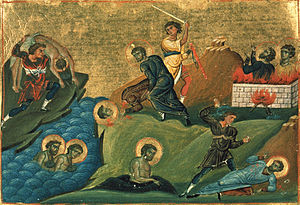Anthimus of Nicomedia
Saint Anthimus of Nicomedia | |
|---|---|
 Miniature from the Menologion of Basil II | |
| Died | ~303 or 311-12 AD Nicomedia |
| Venerated in | Roman Catholic Church; Eastern Orthodox Church |
| Feast | April 27 |
Anthimus of Nicomedia (martyred 303 or 311–12), was the bishop of Nicomedia in Bithynia, where he was beheaded during a persecution of Christians, traditionally placed under Diocletian (following Eusebius), in which "rivers of blood" flowed.
Nicomedia was Diocletian's chief place of residence and was half-Christian, the palace itself being filled with Christians. Christian sources memorialized the "20,000 Martyrs of Nicomedia". The main Christian church of Nicomedia was destroyed on February 23, 303, and the First Edict was published on the following day. The massacres transpired in the Christian communities of Bithynia after altars were set up in the marketplaces, in which no transactions were permitted until a token sacrifice to the gods and the daemon of the Augustus had been performed.
Anthimus took refuge in the small village of Omana, where, when the soldiers of Maximinus were sent to find him, he welcomed them and fed them before he revealed who he was. The detail referring to Maximinus suggests that two persecutions have been conflated.
Philip Schaff and Henry Wace note that a fragmentary letter preserved in the Chronicon Paschale, as written in prison by the presbyter Lucian of Antioch awaiting death, mentions Anthimus, bishop of Nicomedia, as having just suffered martyrdom. Schaff and Wace note that Lucian was imprisoned and put to death during the persecution of Maximinus Daia (in 311 or 312) and therefore conclude that, if the fragment is genuine, Anthimus suffered martyrdom not under Diocletian but under Maximinus.
References
- Schaff and Wace, Nicene and Post-Nicene Fathers, Series II, Vol. I: footnote 32
- Eusebius, Historia Eccles. VIII, chs. 5–6 Persecutions in Nicomedia, mentioning Anthimus.
External links
